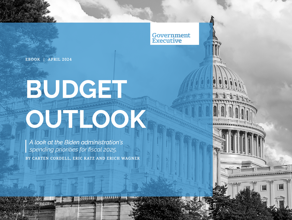Private sector’s best practices can help agencies bring feds back to the office
COMMENTARY | Federal agencies can help employees ease their way back into the office this fall by creating a healthy and flexible workplace culture, writes one observer.
There are a lot of questions surrounding a looming government shutdown, but what is certain is that federal agencies are preparing to increase in-person work this fall after more than three years of telework and flexibility since the pandemic. President Biden’s call to “aggressively” bring employees back into the office met much resistance from the federal workforce this summer. Still, despite the protests, employees will soon find themselves returning to the office more often.
A Government Accountability Office report issued last month found some federal agencies are using only 25% or less of their headquarters space. On the heels of the report’s published findings, the Office of Personnel Management urged agency leadership to increase meaningful in-person work and gather better data on telework performance through new reporting requirements. However, tracking remote employee logins and telework hours may unintentionally affect workforce productivity and team morale.
The shift from an established telework routine will undoubtedly be disruptive for many federal employees. To make the transition back to the office as seamless as possible, managers must take a holistic approach to employee well-being and a healthy workplace culture. Agencies can meet employees where they are and take a supportive and proactive role as the federal workforce gets accustomed to a more regular in-office schedule.
Earlier this year, Pew Research reported around one-third of U.S. workers who were allowed to work from home chose to work remotely 100% of the time, and many chose to work remotely full-time or preferred a hybrid model. Conversely, a SHRM survey of 1,500 human resources professionals found that the top two reasons for in-office requirements are maintaining workplace culture and collaboration. Agencies should gradually transition their staff back to the office so employees can reacclimate to an in-person setting. At the same time, agency managers need to focus on building an inclusive and connected workplace culture to create camaraderie and boost productivity, whether their teams are in-person or remote.
Government agencies must clearly communicate the purpose and timing of in-person work and offer incentives that make their employees feel good about coming to the office. Agencies can learn from the private sector’s best practices to help their employees perform at their best and stay engaged. For instance, corporations often establish “connection days'' that may offer career development, live training opportunities, collaborative workshops, team lunches, and more. Federal agencies can adopt a similar in-person workplace culture to build camaraderie.
Agencies should consider flexible hybrid work schedules instead of mandating a full return to the office. This approach allows employees to balance their in-office and remote work, eases tensions they may be feeling, and demonstrates they are being heard. Managers can consider establishing assigned in-person days so everyone is in the office together. Often, people feel like they are missing out if the rest of the team is together.
Agency managers must lead by example and come to the office to help employees embrace increased in-person workdays. Managers should also give their employees a buffer to make arrangements for personal needs such as childcare and dog walking services. This helps employees manage their responsibilities while adapting to the new workplace routine.
For early career employees, inclusive in-person mentorship and observation opportunities are crucial for skill development. The first year of an employee’s experience at an agency is vital in retaining critical talent long term. Agencies should focus on fostering a sense of community to retain talent.
Managers must stay connected with their colleagues and provide intentional experiences. Federal agencies should invest in employee development opportunities, onboarding programs, diversity, equity and inclusion (DEI) initiatives, and enrichment programs to keep employees engaged and loyal.
Mental wellness should also be a part of the conversation, as well as understanding their employees’ perspectives. Happier employees are more productive and have lower overall absence rates. During a time when federal agencies are short-staffed and overworked, focusing on employee well-being and motivation is crucial.
There is no one-size-fits-all solution to addressing workplace challenges. Agency leaders should actively listen to employee feedback and conduct frequent sentiment surveys to understand employee needs and concerns. Managers should also be prepared to adapt as their team members return to the office. When circumstances permit, give employees flexibility and choice to build trust and show support. Agency leaders should embrace this opportunity to foster an in-person culture and build community to make the transition back to the office as seamless as possible.
Michelle Hay is the global chief people officer at Sedgwick, the parent company of Sedgwick Government Solutions. Michelle has more than 25 years of human resources leadership and consulting expertise, and oversees Sedgwick’s global HR team, identifies and develops talent, furthers diversity and inclusion efforts, and fosters a collaborative work culture and positive colleague experience.



